|
Scientists estimate that many hundreds of billions of neutrinos will
have harmlessly sped through your body by the time you finish
reading this sentence. But despite their abundance, there's only a
10 percent chance over the course of your entire lifetime that even
one of these invisible particles will ever (again, harmlessly)
interact with any other particle in your body. Because of the rarity
of collisions between neutrinos and matter—events that are
necessary to perceive or study these spectral
particles—neutrinos play an expert game of hard-to-get with
physicists, who have designed giant, extremely sensitive detectors
to seek them out. In this slide show, take a tour of some of the
most intriguing neutrino experiments around the globe, and find out
what tantalizing results keep the experts on the trail of the ghost
particle.—Lexi Krock
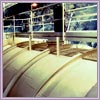

|
|
Homestake
This experiment, now ended, was the first to detect neutrinos
from the sun in the early 1970s. The Homestake detector,
pioneered by Nobel laureate in physics Raymond Davis Jr., seen
here, consisted of a tank of 615 tons of perchloroethylene, a
dry-cleaning fluid. The tank was situated in the Homestake
gold mine in South Dakota. On very rare occasions—about
twice every three days—a neutrino would interact with a
nucleus of chlorine in the liquid and produce a nucleus of
radioactive argon. Davis developed techniques to extract
the few atoms of argon created each month and count them by
monitoring their radioactivity. He found fewer neutrinos than
expected—the famous "solar neutrino problem," which was
resolved conclusively in 2001-2002 by the
Sudbury Neutrino Observatory.
|
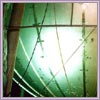

|
|
KAMLAND
An international team of physicists completed construction on
the KAMLAND detector—short for Kamioka
Liquid-scintillator Anti-Neutrino Detector—in 1997 on
the Japanese island of Honshu. KAMLAND detects antineutrinos,
the antimatter opposites of neutrinos, which signal the
latter's presence. The detector uses a telescope made of 1,000
tons of mineral oil and benzene in a stainless steel tank two
thirds of a mile below the Earth's surface to measure
antineutrinos issuing from nuclear power reactors and natural
nuclear reactions. In July 2005, KAMLAND scientists measured
the Earth's total radioactivity for the first time. Their
findings will allow them to better understand what keeps the
planet warm, the volcanoes active, the continents drifting,
the magnetic field churning—all things that enable life.
Until this discovery, geologists relied on the reverberations
from earthquakes to estimate the planet's radioactivity.
|
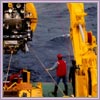

|
|
ANTARES
The aim of this experiment, whose acronym stands for the
rather ungainly Astronomy with a Neutrino Telescope and Abyss
environmental RESearch, is to answer questions about the
composition of deep space by detecting neutrinos on the
seafloor. ANTARES, scheduled for completion in 2006, will use
water 8,200 feet below the surface of the Mediterranean off
the south coast of France to detect the particles called
muons, which are produced when neutrinos from space interact
in Earth's core. Muons create radiation as they pass through
water, and an array of approximately 1,000 photomultiplier
tubes on 10 vertical strings spread over a mile and a half of
seafloor sense and measure them. This image shows part of the
ANTARES during installation in the Mediterranean.
|
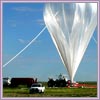

|
|
ANITA
If it's successful, the ambitious and innovative ANITA
neutrino detector will be the first device to identify
so-called high-energy neutrinos created by collisions between
cosmic rays and cosmic microwave photons in space. Studying
neutrinos from these sources offers an unprecedented
opportunity to learn about exotic objects at the edge of the
universe, such as black holes. Beginning in 2006, ANITA will
be a balloon-borne radio detector experiment circling the
Antarctic continent at 115,000 feet during approximately
18-day missions. It will scan the vast expanses of ice for
telltale pulses of radio emission generated by neutrino
collisions.
|
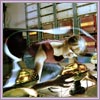

|
|
MiniBooNE
Like many detectors, this experiment at the Fermi National
Accelerator in Batavia, Illinois investigates the oscillation
of neutrinos from one type to another. Since 2003, it has
observed neutrinos created from protons in Fermilab's particle
booster, part of the system that the lab normally employs to
accelerate protons to higher energies for other experiments.
MiniBooNE is a 40-foot-in-diameter spherical steel tank filled
with 800 tons of mineral oil and lined with 1,280 phototubes
(some of which are being adjusted in this image) that produce
a flash of light when charged particles travel through them.
Analyses of these light flashes are already providing
tantalizing information about the nonzero status of neutrino
mass.
|


|
|
MINOS
MINOS, or Main Injector Neutrino Oscillation Search, is a
two-detector experiment at Fermilab that began studying
neutrino oscillations in 2003. It uses a beam of neutrinos
that first pass through a detector at Fermilab, the inside of
which is seen in this image, and then through one hundreds of
miles away deep within the Soudan Iron Mine in northern
Minnesota. The distance between the two detectors maximizes
the probability that the neutrinos will have revealing
interactions over the course of their journey. An
international collaboration of particle physicists at Fermilab
uses MINOS to investigate the puzzle of neutrino mass. The
98-foot-long detector consists of 486 massive octagonal
planes, lined up like the slices of a loaf of bread. Each
plane is made of a sheet of steel covered on one side with a
layer of plastic that emits light when struck by a charged
particle. MINOS will help researchers answer some of the
fundamental questions of particle physics, especially how
particles acquire mass.
|
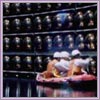

|
|
Super-Kamiokande
This detector began operating in 1996, more than half a mile
underground in a zinc mine in Kamioka, Japan. Japanese and
American scientists erected a huge tank of water 138 feet tall
to hunt for neutrinos. The walls, ceiling, and floor of the
12.5-million-gallon tank are lined with 11,242 light-sensitive
phototubes. These pick up and measure bluish streaks of light
called Cherenkov radiation, which is left behind as neutrinos
travel through the water. Super-Kamiokande detects neutrinos
that nuclear interactions in the sun and atmosphere produce.
In 2001, after several promising discoveries related to
potential neutrino mass, the Super-Kamiokande was crippled
when several thousand of its light detectors exploded. Repairs
on the detector should be completed in 2007.
|
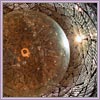

|
|
SNO
The Sudbury Neutrino Observatory is a collaborative effort
among physicists from Canada, the U.K., and the U.S. Using
1,000 tons of so-called heavy water and almost 10,000 photon
detectors, they measure the flux, energy, and direction of
solar neutrinos, which originate in the sun. SNO, located
6,800 feet underground in an active Ontario nickel mine, can
also detect the other two types of neutrinos, muon neutrinos
and tau neutrinos. In 2001, just two years after the
observatory opened, physicists at SNO solved the
30-year-old mystery of the "missing solar
neutrinos." They found that the answer lies not with the
sun—where many physicists had suspected that solar
neutrinos undergo changes—but with the journey they take
from the core of the sun to the Earth.
|


|
|
AMANDA
The South Pole is an inhospitable place to build and operate a
telescope. But crystal-clear ice is an excellent medium for
observing neutrinos as they pass through the Earth. Since
1999, AMANDA, the Antarctic Muon And Neutrino Detector Array
(seen here during its assembly), has used the Antarctic ice to
seek out neutrinos. When the particles interact in the ice
they can produce muons, charged particles that are like
electrons but heavier. The muons create faint flashes of light
as they pass through the ice some 1.2 miles below the surface,
where they are sensed by AMANDA's hundreds of light-sensitive
phototubes supported on 19 tethers frozen in the ice. AMANDA's
goal is to conduct neutrino astronomy, identifying and
characterizing extra-solar sources of neutrinos, which could
provide important clues in the search for dark matter.
|


|
|
IceCube
When it's completed in 2009, IceCube, an international
neutrino experiment involving more than 20
research institutions, will become the largest particle
detector ever built. Setting IceCube's 4,200 optical modules
deep within the South Pole, where the detector joins its
predecessor,
AMANDA, will require drilling 70 holes a a
mile and a half deep each using a novel hot-water drill, part
of which is seen here. The detector's goal will be to
investigate the still-mysterious sources of cosmic rays.
IceCube's telescope will use the Antarctic ice to look for the
signatures of cosmic neutrinos, elusive particles produced in
violent cosmic events such as colliding galaxies, black holes,
quasars, and other phenomena occurring at the margins of the
universe.
|

|

|

